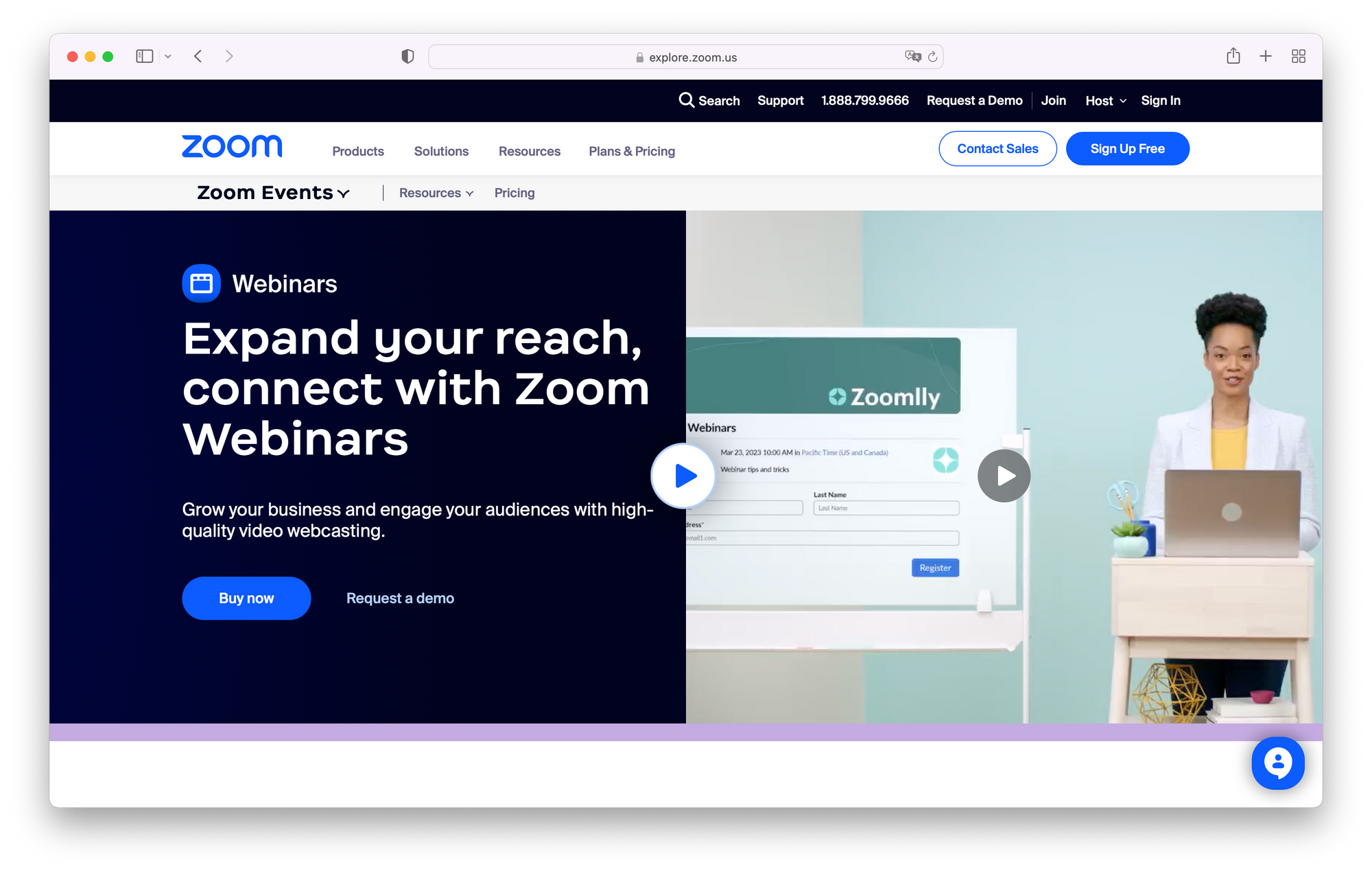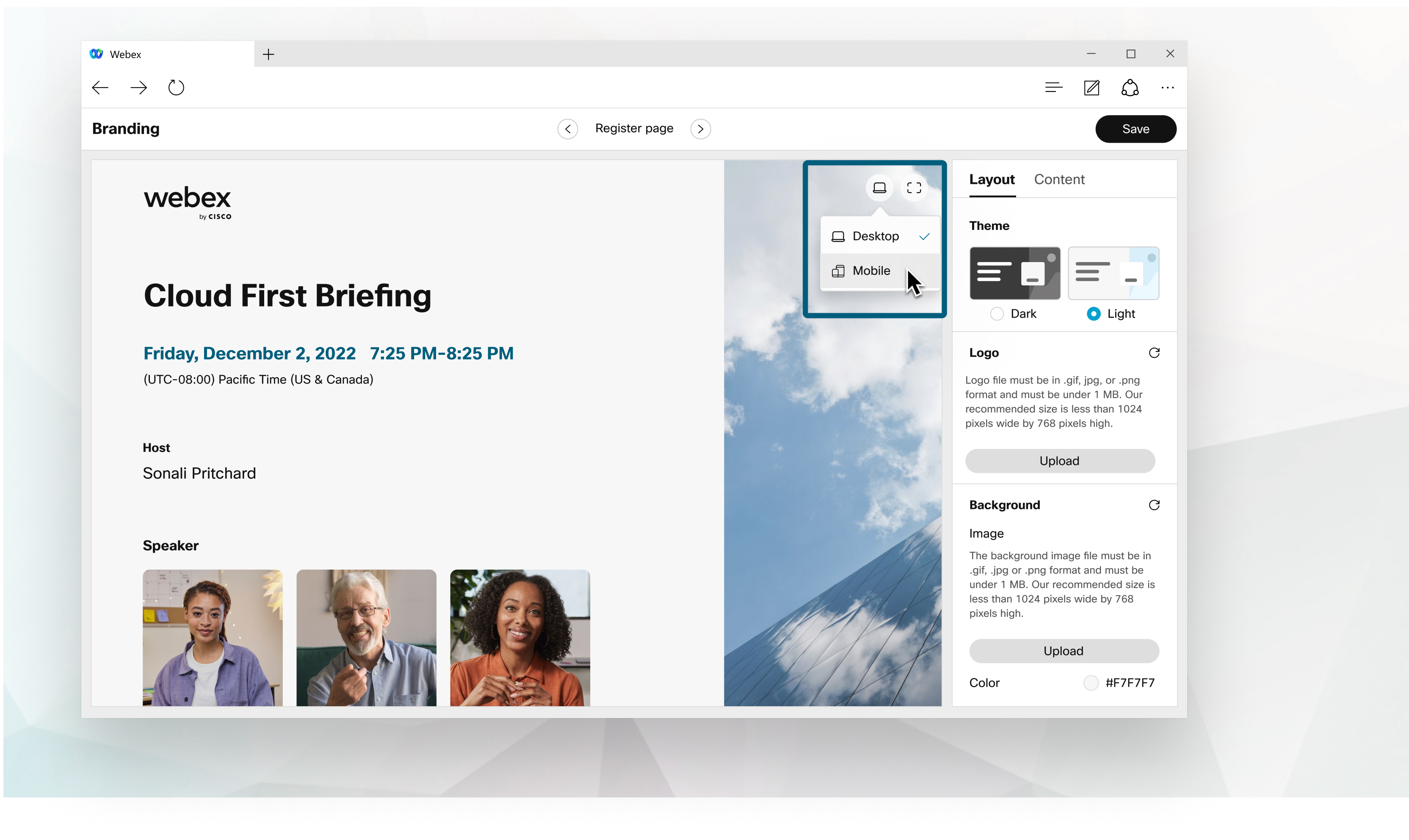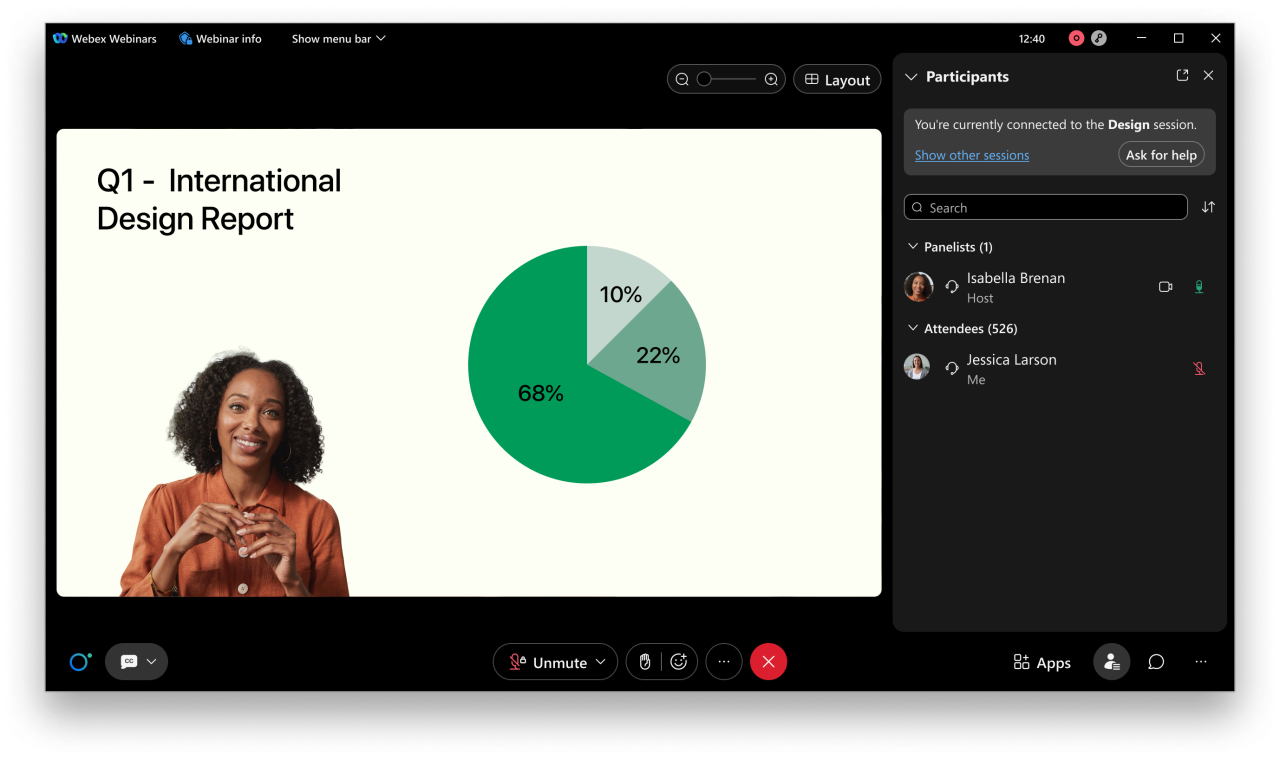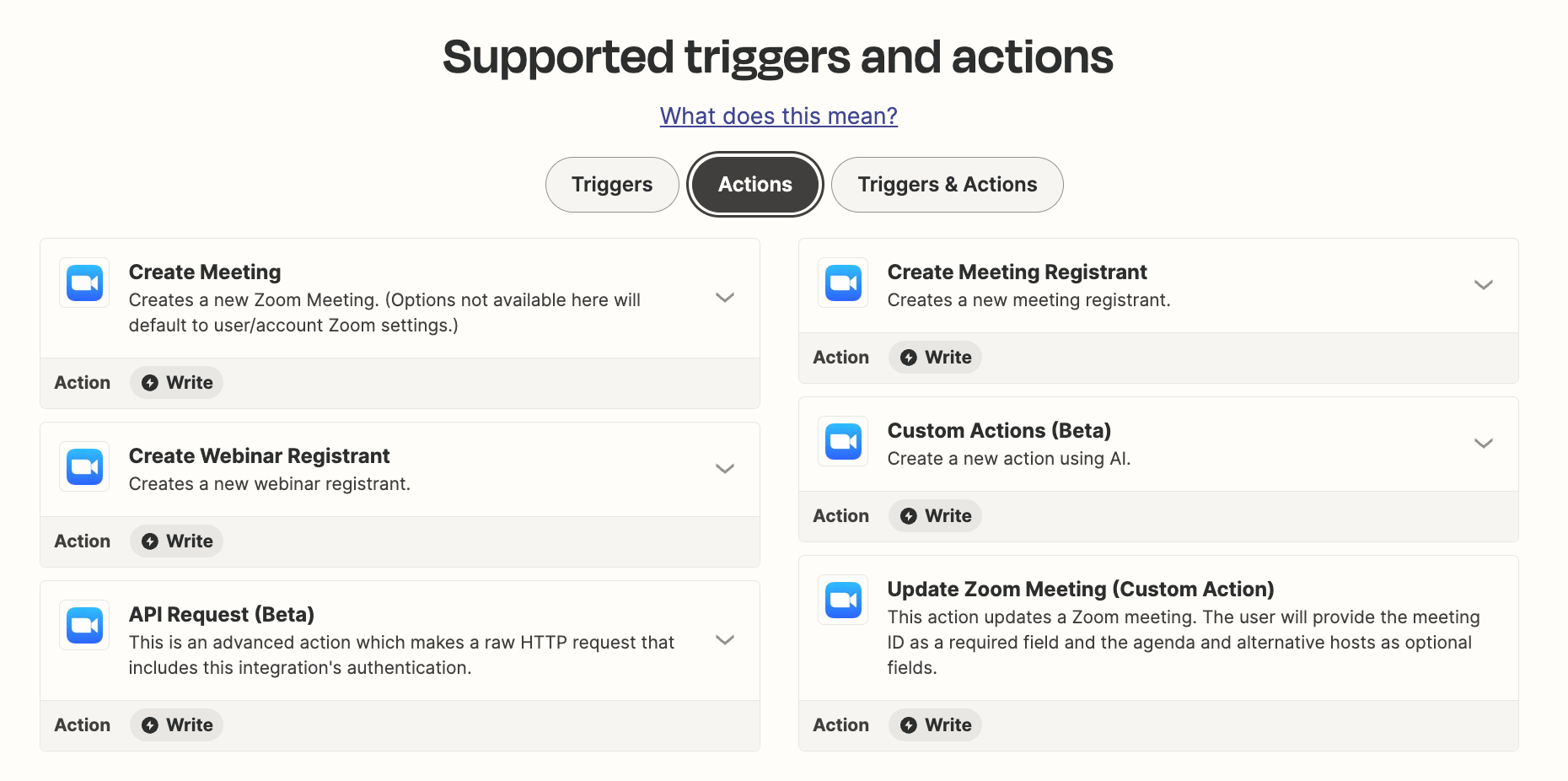Finding the best webinar platform for your brand can be hard, especially when there are so many options to choose from.
If you’ve been looking at the different tools available to host your webinars, you’ve probably encountered tools such as Zoom Webinars and Webex.
Both platforms offer a basic coverage of the features you need to run webinars, no matter what your objective is. But how do they compare to one another in terms of offering, value, and pricing?
In this article we'll take a look at the key features and offering each platform has to offer. Let's jump right in.
How we sourced this data
To make sure we provide you with the best and most unbiased comparison possible, we look at 20+ websites.
These websites include user-review websites, specifically those specialized in SaaS, and the websites of the mentioned tools of course.
Information from these different sources were prioritized in the following order:
- Third party websites (no sponsored posts/content)
- User reviews (G2, Gartner, marketplaces)
- Websites of the tools themselves
Some examples of those relevant sources:
Pricing, viewer limits, feature list, and customer support options are sourced directly on the website of the tools themselves.
We will try to provide the most unbiased review possible. However, the quality of the viewer experience for each tool is subjective. We will be judging it on the modernity and interactivity of the experience.
Before we get into the key features, here’s a brief overview of the two products, including Zoom Webinars vs Webex pricing and online review ratings.
Zoom Webinar overview

Cost
All Zoom Webinar plans require a Zoom One licence ($149.90/year/license) on top of the cost listed below
The cheapest plan for Zoom Webinars is basically a large Zoom call. No custom branding, production tools, event hubs, backstage, or any of the features you're going to want to make your webinar stand out. This is the only plan that you can pay for monthly. They start at:
- $79 /month/licence for <500 attendees
- $340 /month/licence for <1000 attendees
- $990 /month/licence for <3000 attendees
- $2490 /month/licence for <5000 attendees
- $6490 /month/licence for <10000 attendees
But if you want to run branded sessions with event management, you're required to get an annual Zoom Webinar "Sessions" plan. These start at:
- $990 /year/licence for <100 attendees
- $3,490 /year/licence for <500 attendees
- $6,790 /year/licence for <1000 attendees
- $19,990 /year/licence for <3000 attendees
Pricing for larger plans is not available on their website.
Note that this pricing is per licence meaning that if you have multiple people in your team that need a Zoom account, you will most likely have to pay for multiple accounts.
P.S. Zoom also offers a "Zoom Events" plan, but this is geared towards virtual tradeshows rather than webinars or virtual events.
Free plan: Zoom Webinars does not offer a free plan.
Free trial: Zoom Webinars does not offer a free trial.
Reviews
Gartner reviews: 4.5/5 (347 ratings)
Ease of use: 9.1/10
Support: 8.6/10
Support options: Email and live chat (+ phone for Business/Enterprise)
Platform availability: Online, no download, all devices (mobile and desktop).
Zoom is probably the first tool that you think of when it comes to any kind of online video communication, and that's not surprising. They started as a video-conferencing tool and slowly made their way toward webinars, virtual events, tradeshows and more.
But its initial DNA as a video-conferencing tool and its sheer size today has impacted its ability to innovate and keep up with some of the trends we see in the webinar space today.
Users like the "comfort" of using a tool they've already used a million times for video calls, but when it comes to hosting and moderating a webinar the interface can be a little difficult to master. Prompting users to download (and/or open) software to be able to join is also a thing of the past. Turnout rates take a hit from this extra step in accessing the webinar.
Zoom's per license pricing model also makes it difficult to scale webinar efforts, multiplying the cost of the software by every new user you want to add to the team. Another trend we're seeing a lot of is unlimited team members.
The video conferencing-first design of Zoom also seems to negatively impact their capacity to integrate with the most common CRMs like HubSpot and Salesforce, which is an important piece of the puzzles for marketing teams doing lead gen with webinars for example.
Looking for an alternative? Check out our top 10 Zoom alternatives.
Webex overview

Cost
Webex offers two main products that are relevant to webinars: Meetings, Webinars, and Events.
Meetings has pricing available on their website, and starts at $14.5/licence/month - but this product is not adapted to run virtual events or webinars.
When it comes to their webinar software, they offer different pricing tiers:
- $275 /month/licence for <1000 attendees
- $795 /month/licence for <3000 attendees
- $1950 /month/licence for <5000 attendees
- $4950 /month/licence for <10,000 attendees
There is no pricing available for 10,000+ attendees.
All plans must include a Webex Meet licence so add $14.50/mo/licence.
Note that pricing is based on licences, which can be a problem if you have a large team running webinars on Webex, and can negatively impact your capacity to scale your webinars.
Webex offers monthly and yearly plans (with ~20% discount).
Free plan: Webex does not offer a free plan.
Free trial: Webex does not offer a free trial.
Reviews
Gartner reviews: 4.6/5
G2 Reviews: 4.5/5
Support options: Email, call and live chat (depending on plan).
Platform availability: Online, no download, all devices (mobile and desktop).
Webex is a video conferencing platform that allows you to host webinars, meetings, and virtual or in-person events. They provide end-to-end encryption making it a good choice for anyone who wants to prioritize security and privacy.
Their offer is clearly built towards larger, enterprise customers when we take a look at their pricing and feature set. Support is an addon and complex bundles and extras turn buying Webex into a whole process.
Webex has decent engagement features like chat, polls, and Q&A. They also offer an AI assistant to help with note-taking and highlights. This helps a lot with the productivity of meetings. However, this is less useful when running virtual events or webinars.
Looking for an alternative? Check out our top 10 Webex alternatives.
Zoom Webinars vs. Webex Comparison
As you can see from the overview of Zoom Webinars and Webex, they offer very similar products. This makes it difficult for users that are trying to figure out which solution best fits their needs.
Let's compare these two tools across 5 main topics:
- Live experience (host and speaker)
- Pre- and post-webinar experience
- Viewer experience
- Integrations
- Support
1. Live experience
As the webinar host, the software you are going to choose will have a big impact on your capacity to put on a good show for your audience.
Most webinar tools offer a webinar studio to help you run more interactive webinars. Webex offers a similar feature: an interface for the moderators, hosts, and guests where you can create, edit, start polls, manage microphone and camera access, share screen, see live attendees and more.
Reviews of Webex describe it's interface as not being the most user-friendly even though (maybe also because) it offers quite a few features to choose from. It can be easy to get lost between the viewer list, questions, polls, chat, and all the other options. But it gets the job done.

Zoom has it's own version of that: an admin interface where you can create, edit, start polls, manage microphone and camera access, share screen, see live attendees and more.
Zoom's host and panelist experience is built off the meeting experience and isn't optimized for speakers and guests. It has a lot of options that can make accessing key parts of moderation complex (chat, participants, recording, Q&A, unmuting viewers, etc.).
There are different roles (Host, Co-host, Panelist) to manage permissions and only give access to the necessary features. This can come in handy by avoiding one of your panelists from stopping the webinar before it's over.

Both tools offer similar speaker and moderator features to run your webinar. But Webex's "Studio" has a few more useful features geared towards webinars (especially when it comes to branding) and set out in a much more user-friendly interface.
Winner: Webex

The Modern Webinar Experience
Start for free with up to 50 registrants. No credit card needed.
Start for free2. Pre- and post-webinar experience
When it comes to your viewers' experience, Webex and Zoom Webinars both cover the basic features you are going to need to run webinars.
They both offer customizable and branded registration pages, automated reminder and follow-up emails, and replays (Zoom Webinars and Webex do not record all webinars by default, so be careful if you go with them to run your events).
Webex offers a landing page builder with both desktop and mobile layouts that you can customize to your brand with your desired layout.
Webex has features for recurring events and simulive sessions (providing a live experience to the viewer with nobody managing the event), that Zoom Webinars doesn't offer. They also provide more detailed viewer data.

Zoom Webinar registration pages and emails give very few options in terms of customization and branding, even with the different template options. This can negatively impact conversion rates on your landing page, meaning fewer people sign up to your webinar.
Webex gives you more flexibility and more options when it comes to post-event automation (for example using viewer data) and integrations but we'll get into that later.
But both tools allow you to build your own landing pages with 3rd party tools and send registrants to your webinars via automation tools.
Because of the additional features and similar ease-of-use, Webex takes the win in this category.
Winner: Webex
3. Viewer experience
Webex offers a relatively modern viewer experience and lets you brand your webinar with profile pictures, background images, logos, social links, and more.
Polls, questions, and chat all have their own separate panels - forcing users to navigate back and forth to cover everything that's going on. This distracts users from your content, and reduces engagement on polls (because users might miss them).

You've already been in a Zoom call. Well, the viewer experience of a Zoom Webinar is extremely similar to that of a call — maybe even indistinguishable.
Zoom Webinars gives you a few options to brand your webinar (depending on your pricing plan) with background images, logos, and more.
Polls, questions, and chat all have their own separate panels - making users to go back and forth to interact with them. This distracts users from your content, and reduces engagement on polls (because users might miss them).
The main issue with Zoom Webinars' viewer experience is that it's too familiar. It reminds users of a call and leaves them in a very different mindset from that of a webinar.

Both platforms let you stream in 720p (or 1080p for more expensive Zoom plans), but Webex is going to provide a higher quality experience on all plans.
Winner: Webex
4. Integrations
Webex integrates with Salesforce, Eloqua, some CRMs, and many other tools of the modern marketing stack. And these integrations are available on all plans - regardless of viewer limits. Some users have reported that these native CRM integrations provide adequate data but are far from what they were expecting in terms of quality. Webex also offers an API giving tech-enabled webinar teams more flexibility when it comes to running and automating they webinar strategy.
Looking for the webinar tool with the best HubSpot integration?
Check out Contrast for free (4.9* on the HubSpot Marketplace).
Zoom Webinars integrates with Marketo, Pardot, Eloqua, HubSpot, Salesforce, and many other tools of the modern marketing stack. These integrations are available on all pricing plans making it a good choice for smaller teams with less budget. However, some users have reported that the CRM integrations do the "strict minimum" but far from what they would expect in terms of quality. Zoom Webinars also has an API allowing tech-heavy webinar teams a lot more flexibility when it comes to running and automating their webinar strategy.
Both Webex and Zoom Webinars have Zapier integrations, allowing you to connect them to 3000+ tools. They both offer actions around the participant registering, attending a live and to register people to webinars. However, Zoom offers both triggers and actions around organizing webinars and will allow for better webinar automation to teams who use Zapier.

Winner: Zoom
5. Support
Both tools offer very similar support options: email and live chat.
Webex has a better help center than Zoom Webinars, making onboarding for new Webex customers onto the tool easier and solving recurring problems or questions you might run into.
Zoom Webinars also provides support documentation in the form of a help center where they answer basic questions you might have but it's more limited when it comes to complex topics.
Users rate Zoom Webinars' support as higher than what we could find for Webex — even if the options are limited.
None of the two platforms is a clear winner on average across all plans, but the numbers have spoken (and we listen).
Winner: Zoom
Which is better — Zoom Webinars or Webex?
So we just took a look at each of these platforms, but which one is going to take first place?
Webex won on all 3 of the 5 categories (and important ones at that), however it is quite a bit more expensive than Zoom Webinars depending on your volume and needs.
If your only goal is to run webinars while investing the least amount of resources possible or on a low budget, Zoom Webinars can be a good choice to get started. However, it won't be the best choice for your audience and will require extra work to integrate with your CRM or other tools of your marketing stack.
If you're looking to put on a more professional and larger-scale webinar experience, Webex is the best option even if it will be a bit more costly. However, be wary of the licence-based pricing that will make it difficult to scale webinar efforts into other teams. The integrations to other tools will allow you to leverage webinar data to close more deals and improve your strategy.
Go beyond webinars
Both Webex and Zoom Webinars are great tools for running your webinars.
However, there are many other alternatives to these two webinar tools offering a wide variety of features and pricing plans — and of course don't forget to take a look at Contrast.
Contrast is the most modern webinar tool on the market, covering all the basic features you're looking for in a tool while providing a fun, authentic and engaging experience to your audience.
We also offer tools to help you repurpose your webinar, a Netflix-like branded Channel to host all of your replays and upcoming events, all while providing the highest quality branded video experience on the market and stellar CRM integrations.

